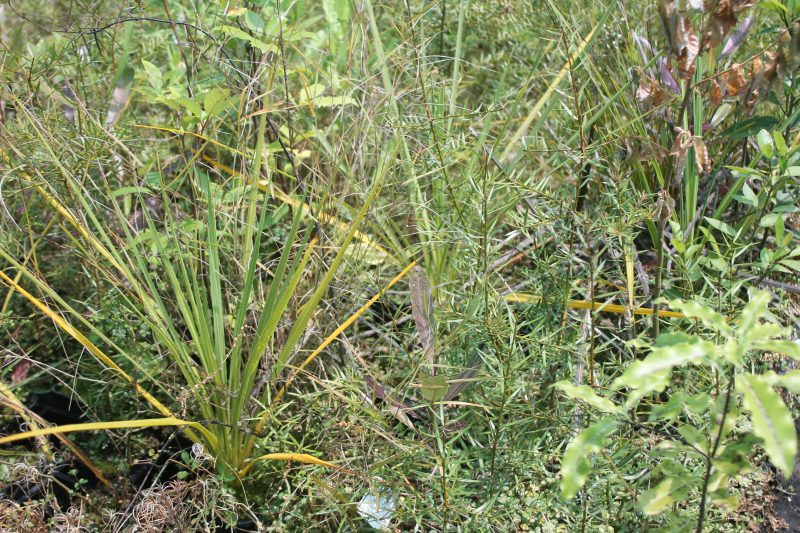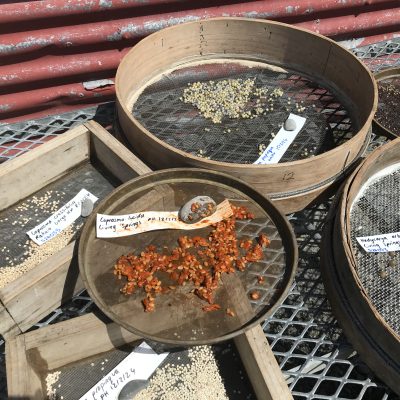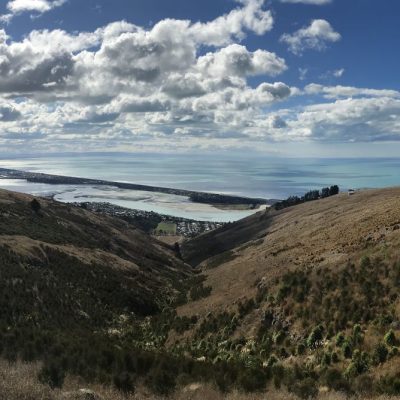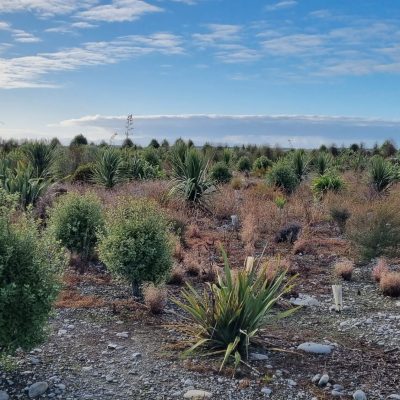About our “Duff” Lines
What is duff?
The term “duff” is used in forestry to refer to the layer of decomposing organic material on the forest floor, including leaves, needles, branches, and other plant material. This layer, also known as leaf litter, is crucial in nutrient cycling and ecosystem health.
The leaf litter serves as a protective layer for seeds, promoting successful germination and providing a suitable environment for young plants to establish themselves. The organic material also contributes to the development of a loose, well-aerated soil structure that facilitates root growth. Microorganisms in the duff layer play a role in breaking down organic matter. This microbial activity can influence the availability of nutrients in the soil, creating a more hospitable environment for seed germination and subsequent seedling growth.
In our plant production at Wai-Ora, the Duff lines refer to mixed lines of plants that grow from mixing the forest duff with our potting soil and allowing the plant seeds in the duff to germinate. As you can imagine, this would lead to a variety of plants that would naturally occur in the area the duff comes from.
Using Duff as an indicator of what should be planted.
While seedlings provide useful information, they should be considered one component of a broader ecological assessment. Additional methods such as vegetation surveys, soil analysis, and historical data can provide a more comprehensive understanding of the plant community.
The types of seeds present can vary seasonally, and the seed bank may not be representative of the entire plant community at a specific point in time. Some seeds may remain dormant in the soil for extended periods before germinating. This dormancy can affect the timing and composition of the emerging plant community. That means that a line of duff from the nursery may not be an accurate mix of plants that would be there in an established forest.
While seeds found in the detritus on the forest floor can offer insights into the potential plant species in an area, their interpretation should be done cautiously, considering factors like seed viability, germination requirements, spatial variation, and the potential presence of non-native species. Combining seed analysis with other ecological assessments provides a more accurate representation of the plant community dynamics in a given location.
Duff-grown plants are robust
Leaf litter is rich in organic matter, and when mixed with a growing medium, it can contribute valuable nutrients to support plant growth. The decomposition of the duff releases nutrients into the soil, enhancing the fertility of the growing medium.
Leaf litter provides a habitat for a diverse community of microorganisms, including bacteria and fungi. These microorganisms are crucial for breaking down organic matter, decomposing complex compounds, and facilitating nutrient cycling.
Mycorrhizal Fungi
The duff layer can also serve as a source of mycorrhizal fungi. These fungi form symbiotic relationships with plant roots, aiding in nutrient uptake and promoting the overall health of the germinating seedlings. The extensive network of fungal hyphae acts as an extension of the plant’s root system, significantly increasing the surface area for nutrient absorption. This is particularly important in nutrient-poor soils.
Mycorrhizal associations also enhance the plant’s ability to absorb water from the soil, contributing to increased tolerance to drought stress. These associations contribute to the adaptability of plants to various environmental conditions, including changes in soil pH, temperature, and nutrient availability.
Wai-Ora’s Duff
Usually, we collect duff under very tall wild specimens, so we don’t have to climb ancient trees to get their seed. Most of the time we aim to grow Kahikatea, Totara, and Mataī (Podocarps) from the lines, but so much more germinates. Plenty of unwanted seeds are in the duff too, so we must be diligent about weeding the duff trays for introduced species. What we keep in there are natives. The idea is that the mix of seedlings that germinate from the duff is representative of what would naturally occur if the big shady tree were to fall over and allow light and moisture to reach the seedlings. This also means that should the forest be allowed to grow outside its current boundary, those plants would begin to germinate along where the forest regenerates.
Collecting Duff
We collect the duff from established remnants of bush from the foothills to Banks Peninsula. This involves gathering the layer of decomposing organic material that accumulates on the forest floor, or in seed nets, as pictured. First, whenever collecting seed, it is imperative to get permission from the landowner, even if it is on public land. Setting up seed nets requires an extra layer of permission since the net can sit on site like this for months or even years.
Site selection
We choose our sites based on the species we aim for in collection. If we are collecting the duff from the forest floor directly, we gently rake the detritus into large bags, being mindful not to disturb the underlying soil or vegetation. Also, because leaf litter is an important part of the ecological functions of the bush, we leave a healthy amount behind for the forest ecosystem. Avoiding collection from areas with rare or sensitive plant species. And we’re cautious not to disturb wildlife habitats.
Tracing
As with all of our seed collection we note the date, volume and location of where we collected. Tracing each plant back to its origin is an integral part of eco-sourcing.
Production
We grow nearly all our Podocarps from duff, which is about 13% of our annual production. In the last few years, we’ve grown an average of 48,000 units of duff per year.
What kinds of plants germinate in the duff?
The characteristics of the forest duff, and in what kind of forest it is collected directly impact what species grow. For example, when we collect duff for podocarps on Banks Peninsula, we also get Ngaio and Poroporo in the mix, as they naturally occur in abundance there. Neither of those show up in the duff from the Mount Hutt region because they are too frost-sensitive to survive there. Forest duff composition can vary widely, and the species mix can be inconsistent year over year. Some years there will be a lot more of one species than another, reflecting what birds were eating before roosting in the canopy layer above where the duff was collected.
The seed bank in forest duff represents a reservoir of seeds that may include both current and historical species present in the area as well. Some seeds may be from plants that are currently present, while others might be from species that were present in the past or that have dispersed from nearby areas. Most duff lines we grow will contain Tī Kōuka and mingimingi and in some cases, we rely on these fast-growing species (like Māhoe) to come from duff because they are so easy to grow, we don’t bother specifically collecting seed for them.
One of the difficulties in producing plants from duff is that not all seeds in the duff layer may be capable of germinating. Some seeds may require specific environmental conditions to germinate. Therefore, the presence of seeds does not guarantee the germination of the corresponding plant species. As happens frequently with eco-sourced plants, production is inconsistent. That unpredictability is one of the best parts of duff. We are surprised by what it gives us.






